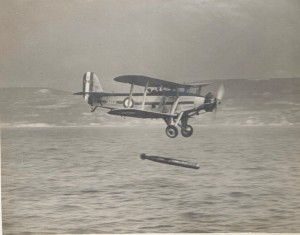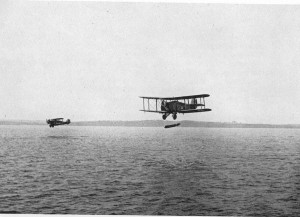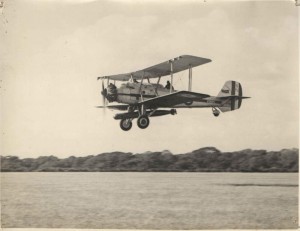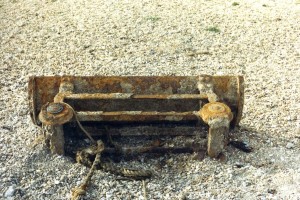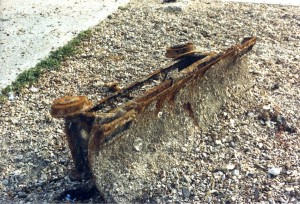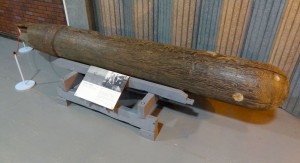Stokes Bay Pier and the Torpedo Development Unit
The RAF Torpedo Development Unit was made up of an armed services section who maintained and flew the various torpedo launching aircraft, a civilian section of scientists and engineers, plus workshops. The civilian offices were wooden huts on the old parade ground within the Victorian Fort Grange which gave its name to the air station R.A.F. Grange. It is now part of HMS Sultan.
Stokes Bay Torpedo Dropping Zone
The old pier at Stokes Bay closed for use in 1915 and the Admiralty used it during WWI for the transportation of munitions and fuel. In 1922 the pier was sold by the LSWR and it was bought by the Admiralty, together with the railway line south of Gosport Road Station. The pier was converted with the addition of a narrow gauge railway to allow the recovery of practice torpedoes. Small trucks for transporting the torpedoes ran on this line. The Torpedo Development Unit at H.M.S. Vernon operated a torpedo test run at Horsea Island but when it became necessary for a longer test range Stokes Bay came into use. The Admiralty made use of Stokes Bay pier to retrieve the dropped torpedoes and to deploy the targets. To get to the boat necessitated descending a flexible rope ladder hanging under the pier and boarding the boat as it went past. During the Battle of Britain, the T.D.U. workshops were bombed and they moved to a temporary workshop beneath the Ashley Wallpaper factory in Lees Lane, Gosport. The purpose of the Stokes Bay range was to observe the performance of torpedoes when they were dropped from aircraft. The torpedoes were not carrying any explosives and the anticipated use of the range was four drops per day.
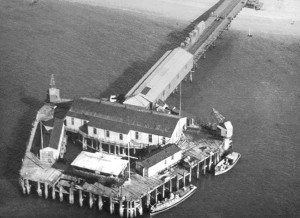 |
Between 1929 and 1932 the Torpedo Development Flight flew out of RAF Station Gosport, situated at Grange Airfield between Forts Grange and Rowner. On 2-11-29 No.36 Squadron (Hawker Horsleys) arrived from Northolt for torpedo dropping. It departed 14-11-1929. The torpedo training course involved practice low-flying over the sea, followed by practice drops of dummy torpedoes. These were dropped alongside a picket boat located in Spithead waters, and photographic records were taken of drops. The pilot was shown photographically any errors he might make, a good drop being made with the torpedo inclined downwards at about six degrees and dropped from a height of 15 to 25 feet. These training exercises led up to an attack with runner torpedoes (collision heads) against some obsolete naval vessel. It was a great day, and frequently a proud one, for the chief instructor. Normally, two attacks would be made with the ship holding a steady course.
The Torpedo Training Unit (Feb 1937 – 19 Mar 1940) also flew from RAF Station Gosport. The Torpedo Development Unit (1939 – 11 Nov 1943) then used the station and finally an armed services section known as the Air Torpedo Development Unit (Flight Section) ATDUFS maintained and flew various aircraft out of Grange airfield and launched torpedoes at the Dropping Zone located off the beach at Stokes Bay from Nov 1943 – 18 May 1956. In 1943 the Torpedo Experimental Establishment, Stokes Bay, was merged with the Torpedo Development Unit on the Gosport Station – the combined units then being known as the Aircraft Torpedo Development Unit. The Unit was organised under a joint bureau by the staff of the Ministry of Aircraft Production and the Director of Torpedoes and Mining, Admiralty. This decision brought the Chief Torpedo Development Officer and his staff formerly based at Stokes Bay within the Aircraft Torpedo Development Unit organisation. The Unit was now using Beaufighter, Wellington and Manchester Aircraft.
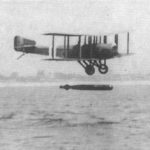
The first successful land plane to be used as a torpedo- bomber was the Sopwith Cuckoo. It had a short service life from 1918 to when its operational career ended with the last unit to use the type, No. 210 Squadron, disbanded at Gosport on 1 April 1923.
It was followed in succession, by the Blackburn ‘Swift’, ‘Dart’, ‘Ripon’, ‘Baffin’, ‘Shark’, and ‘Fairey Swordfish’. In addition to these the Torpedo Development Flight also used the Hawker ‘Horsley’ and the Vickers ‘Vildebeeste’.
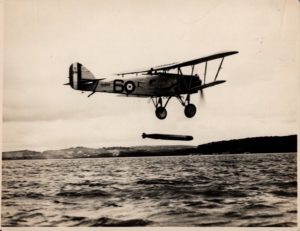 |
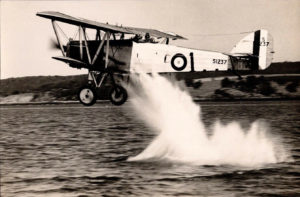 |
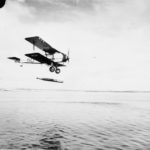 |
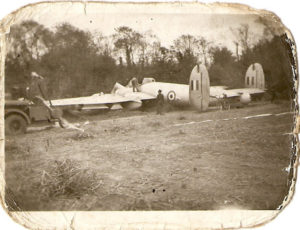
Numerous others underwent torpedo trials at Stokes Bay, such as the Blackburn Firebrand TF.III in 1945 and the Bristol Brigand. A Brigand that had taken off from HMS Siskin on 8th October 1953, crashed at Holbrook 300 yards from the end of the runway. Details here. https://gosport.info/memories-stories/memories-of-the-gosport-bomber-crash-in-1952-53/
In 1947 the ministry of Supply informed Gosport Borough Council that it wished to continue using Stokes Bay sea area as an aircraft range for research on torpedoes and torpedo installations in aircraft, as an air to sea range, and aircraft torpedo development unit; The Council agreed but wanted assurances that no torpedoes were to be dropped on Stokes Bay Beach!
In 1951 it was reported that the torpedo range at Stokes Bay was no longer satisfactory. With the advent of the jet aircraft and consequently greater envisaged speeds aircraft needed more room for manoeuvring and Stokes Bay with its congested shipping lanes was no longer suitable. The torpedo trials unit was moved to RNAS Culdrose in 1956 when RN Air Station HMS SISKIN was closed down and the airfield at Grange became HMS Sultan.
In 1953 the Admiralty fenced in the pier. The last use of the pier was by the Royal Naval degaussing service (A.D.G.E.) until it moved to Fort Rowner. The buildings on the pier were removed in the 1960s and the pier was demolished in stages between 1972 and 1976. In 1985 the Royal Engineers diving establishment, Marchwood, offered to remove the remaining 90 piles and 2 crane bases, free of charge. During the final stages of this exercise in July 1988 a torpedo trolley was recovered from the sea bed and dumped on the beach. I wonder where the recovered trolley finally went? A wood training torpedo recovered from the sea at Stokes Bay can be seen on display at the Fleet Air Arm Museum, Yeovilton.
| ROYAL AIR FORCE AIRCRAFT OF THE INTER-WAR PERIOD© IWM (MH 24) | ROYAL AIR FORCE AIRCRAFT OF THE INTER-WAR PERIOD© IWM (MH 45) | ROYAL AIR FORCE AIRCRAFT OF THE INTER-WAR PERIOD© IWM (MH 27) |
| ROYAL AIR FORCE AIRCRAFT OF THE INTER-WAR PERIOD© IWM (MH 23) | ROYAL AIR FORCE AIRCRAFT OF THE INTER-WAR PERIOD© IWM (MH 20) | ROYAL AIR FORCE AIRCRAFT OF THE INTER-WAR PERIOD© IWM (MH 15) |
The Mark XII torpedo was designed in 1935 (and entered service in 1937) as an aerial torpedo for use by the Fleet Air Arm and RAF Coastal Command. It was a development of the 18-inch Mark XI, which had a larger 211 kg warhead (compared to 176 kg on the Mark XII), but a shorter 2,300 m range and lower speed of 35 knots (65 kph). The Mark XII reduced the warhead size, but increased the speed and range to 69 kph at 3,000 m range or 74 kph at 1,400 m range. The torpedo was 4.95 m long, 450 cm wide and weighed 702 kg. It was powered by a 140 hp burner-cycle engine.
Thanks to Warthunder for details:
https://wiki.warthunder.com/18_inch_Mark_XII_(450_mm)
Pilot Officer ALFRED BAILEY, R.A.F. 40976, Pilot Officer, Royal Air Force Age 26 Died 1.8.1940
Pilot Officer ALFRED BAILEY, Royal Air Force, 26 years of age, was serving with No 22 Squadron based at RAF Gosport, was engaged in flying a Vickers Vildebeeste aircraft on 1st of August 1940, with him were 977714 Aircraftsman Class 2 E.S Budd and a civilian scientist named H. Dawson. The aircraft, K 6408 was part of the Torpedo Development Flight, was scheduled to drop a torpedo on the range off Stokes Bay and then return to the airfield at Gosport less than a mile away. P/O Bailey approached the range, adjusting his altitude for the optimum height of 50 feet above the waves. Observers on Ryde Pier noted that the aircraft’s nose suddenly dipped, whether as a result of the gusty wind is not known but, with no height to recover, the Vildebeeste crashed into the sea.
As with all torpedo drops, the range was policed by various support boats. These boats immediately went to the aid of the sinking aircraft. A/C2 Rudd was rescued from the sea and although badly injured, after hospitalisation he recovered. A/C2 Rudd was the only member the aircraft’s crew to survive. The civilian scientist and Pilot Officer Alfred Bailey were dragged to the seabed with the aircraft, and were not recovered until the 4 days later. The wreckage of the machine was located by divers, and hauled to the surface. The bodies of the two unfortunate men were at last recovered from the mangled when the salvage vessel moored up at Priddys Hard.
P/O Alfred Bailey, R.A.F., was buried on the 7th of August 1939, and is laid to rest in the War Graves Section, Row 1 Grave 6, and is commemorated by a CWG headstone. (Mr H. Dawson was buried at his hometown of Bradford, Yorkshire.
https://www.thunder-and-lightnings.co.uk/memorial/entry.php?id=53
